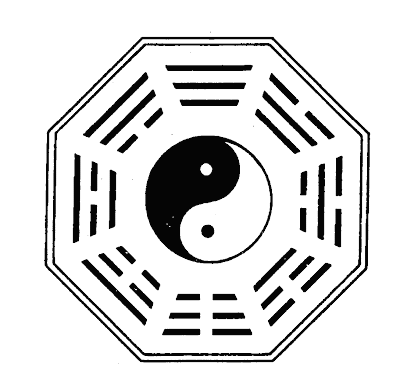


Tibetan Prayer Wheel: Devices for spreading spiritual blessings and well being. Rolls of thin paper, imprinted with many, many copies of the mantra (prayer) Om Mani Padme Hum... are wound around an axle in a protective container, and spun around and around.
Tibetan Buddhists believe that saying this mantra, out loud or silently to oneself, invokes the powerful benevolent attention and blessings of Chenrezig, the embodiment of compassion.


HAND OF FATIMA (daughter of Muhammad): Many Muslims believe that the image of the hand with an eye in the center will protect them from the "evil eye". While this symbol often appears on magical charms, amulets, and jewelry, it is seen in many other places.
Many serious Muslims view this as folklore or superstition. Many people place it in their homes where the guests can see in the moment they enter. As there is a widespread belief that it will protect the house and household from disasters primarily fire.


TRIDENT: Called "the devil's pitchfork," it has symbolized major gods in various pagan cultures. In India, it is linked to the Hindu "trident-bearer" Shiva, spouse of the skull-bearing goddess Kali. More recently, thisthree-sponged spear has been used by Hindu militants in India to intimidate Christians.
It was symbolic of lightning. Here Poseidon or Neptune, ruler of the sea or underworld, holds the trident, traceable to the horned, hoofed sun-god of Babylon, who carried the trident or pitchfork. The trident is also a representation of the male-female symbol.

WISHBONE: Civilizations dating back to the 4th Century (Etruscans, Romans... Britain, America) have held turkey or chicken wishbonecontest. Pulling the dry turkey or chicken bone until it snapped ("lucky break"), they believing the winner's wish or dream would come true.
In today's increasingly superstitious culture, many believe that this symbol will "catch" their dreams, bring good luck, and make their wishes come true. As in contemporary witchcraft or magic, the object becomes a channel of "good" energy. Astrology and horoscopes link it to Saggitarius. It might also be confused with the Lambda (looks like a lower case, upside-down "y"), the Greek letter adopted by the International Gay Rights Congress in 1974 as the global symbol of homosexual "pride".

Taijitu: representing the principle of yin and yang, which in Chinese means the two opposing principles in nature (light/dark, male/female), it also represents mortal world and nether world.(White and Black colour in the symbol).
"The Supreme Polarity that is Non-Polar"__ the ancient Chinese symbol used originally to represent a widespread belief in unity, polarity, holism, and magic.
Summary: Superstition is in every culture and history, it comes from many of people who believe in spite of evidence. People often use their superstition symbol on Tattoo, Jewellery, Decorations. To protect themselves from fears you may call that a believer, it also symbolise what fear or trust in magic you are.




